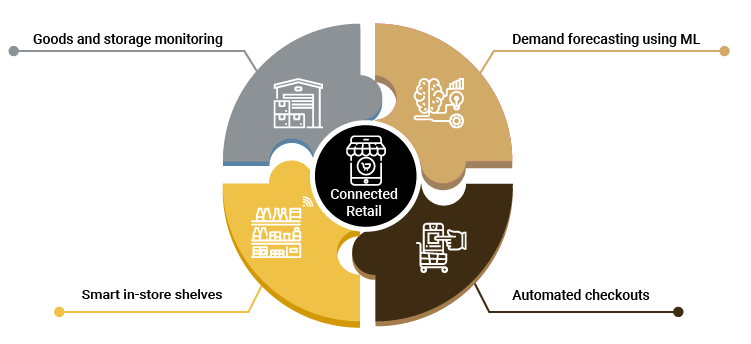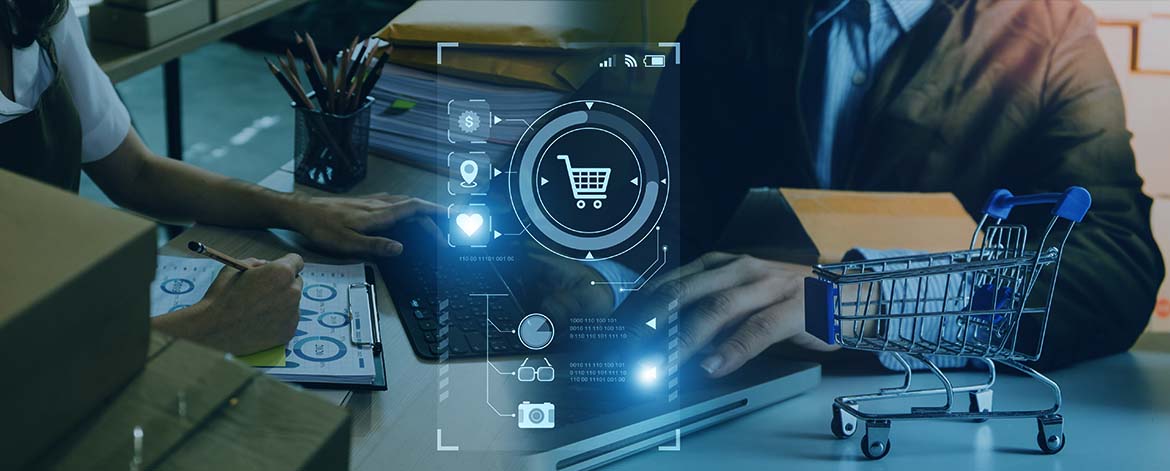With the adoption of the Internet of Things (IoT), Cloud Computing, and Machine Learning, traditional retail scenario has dramatically changed giving rise to connected retail, that provides organizations with innovative opportunities to accumulate and analyze data and ensure successful business from different channels. To keep flourishing in a highly competitive industry, retailers need to emphasis on outspreading their reach to customers with several stores/outlets, handling supply chains, and provide exceptional end-user experience. A recent study by McKinsey suggests that U.S. retailers that have adopted data and analytics into their supply chain have experienced up to a 10% increase in operating margin over the last five year. The study also estimates that the IoT in the retail industry will economically impact in the range of $410 billion to $1.2 trillion per year by 2025. Integrating IoT, Machine Learning and Cloud Computing services in the retail environment not only reduces IT costs but also improves customer experience and efficiency, streamlining the workflow.
Let us see how these new technologies transform and stimulate key benefits for the retail industry.
Anytime, anywhere monitoring of goods and storage
Storage containers containing raw materials or products can be tracked using IoT devices which are based on the location tracking sensors like GPS sensor. The location tracking device will have a location sensor attached to it which will have the capability to broadcast its location via GPS and remote satellites. The captured location details is sent to the cloud for processing and then pushed to any connected mobile/desktop application where users can run time, see the location, and monitor it.
Also, a combination of IoT sensor devices can be used to monitor environmental storage parameters for raw materials like edible or chemical goods. Wireless sensors will monitor critical environmental parameters like temperature, humidity, light, moisture, etc., which will be reported to the controller, and constant comparison between the threshold value and received value will be done. If any of the parameters is less than the threshold value then the actuator will turn on and control the parameter. Even alarms can be set to report the same.
Demand sensing using Machine Learning (ML)
Demand sensing algorithms which are based on Machine Learning extracts data from POS systems, warehouses to understand if the sales graph has increased or decreased compared to traditional patterns. These algorithms continuously and automatically analyzes factors which are influencing sales, and constantly offers new adjustments to short- term plans for sales expectations. Models based on predictive sales analytics can be used to clean the data that is extracted from the systems to check if the data variables are relevant to the organization and if can impact sales. Data sensing algorithms use this cleansed data and help various companies and organizations to build predictive models to understand and analyze the outcome of sales in the market. It can also help the organization to discover new opportunities based on the market needs.
Also, there are intelligent algorithms based on demand sensing for supply chain management that takes into account factors like weather condition, seasonal trends, holidays, etc. while predicting future market requirements for businesses. Many companies reported an increase of 5 to 15 percent in forecast reliability (up to 85 and even 95 percent) by integrating machine learning to their existing systems. Demand sensing enables businesses to swiftly address unexpected and dynamic changes in customer needs.
Efficient inventory management with smart shelves
Smart shelves have been in the market since early 2000s, amazon and Microsoft are constantly improving their technologies in this area. Smart shelves help in checking the inventory – if the product stock is over on that particular shelf. Smart shelves can be developed using RFID tags, RFID readers, and RFID Antennas.
The RFID tag attached to a product transmits data to RFID reader. The information which is collected from the RFID reader is sent to the IoT device and the data received is analyzed and calculated to check for any theft, inventory management, to understand customer interest, automatic ordering, etc. The stocks reported from the RFID reader is pushed to cloud databases. Cloud-connected mobile applications can help the user to understand the database on the go so that he can manage the inventory more efficiently. For stock security, the tag readers can be placed at high risk points like exit gates, which can further trigger alarm (sensors) to beep constantly.
To explain, Amazon launched the Dash Smart Shelf aimed at small businesses. The shelf has a built-in scale that can be set up to automatically place orders with Amazon to restock when supplies are low; alternatively, it can send notifications to alert the business if automatic ordering is not wanted.

Improving customer experience
There are multiple technologies like IoT enabled beacons, automated checkouts, in-store layout optimization, ML based data analytics, etc. used to enhance the customer experience.
Personalized Advertisements
Beacons are very useful components for IoT. Beacons work as radio transmitters on low energy over BLE/Bluetooth connections. They are usually used to send push notifications on the store mobile applications of smartphones based on the location proximity of the user. Some of the North America’s top retailers, including Macy’s, Target, Urban Outfitters, etc. uses beacon technology for their stores.
Automated checkouts
IoT devices like smart carts or self-checkout kiosks can be installed at a particular place in the store so that the consumer will not have to wait in long lines. Self-checkout kiosks will have barcode scanners, where users will have to log in to their account/mobile payment apps, scan the codes of the products, and add it in the cart. The cart will have image sensors attached which would take multiple pictures to understand the product and weight sensors to check the weight. The POS will accordingly deduct money from the consumer’s account.
Layout optimization
Layout optimization helps the retailer to understand what products are sold the least and where they can put them forward for selling. To achieve this, retailers can use Aisle Analytics software with infrared sensors to understand customer patterns. The sensors observe traffic patterns and identify where customers spend the most time to determine a spot to place the most popular and profitable items. Retailers can also add value by generating personalized product recommendations for buyers with the help of cloud computing and analytics. Because of the cloud’s expanded computing power and capacity, it can store information about user preferences, its location, and run ML algorithms to derive intelligent insights enabling product or service customization.
To summarize, retail businesses are seeing growth from integrating and gradually switching to new-age technologies that reduces their operational and infrastructure costs, improves data security, provide real-time access to inventory, streamlines supply chain management, and provides an enhanced customer experience. At VOLANSYS, we offer enterprise grade IoT, Machine Learning, and cloud computing services including design, development, deployment, migration, integration, optimization, and analytics that helps retail companies transform their business operations with enhanced efficiency and improved customer engagement elevating their businesses to next level. We have helped one of the leading retailer of POS and touchscreen displays to increase revenue per customer and reduce customer acquisition time by developing cloud SaaS solution that automated device registration, reduced time to display ads, and enabled remote device management. Know more about the case study here. We also provide consulting services that enable organizations to create a customized IT infrastructure by integrating IoT, cloud, and machine learning required for their business model.
About the Authors:

Rajvi Kamdar
Rajvi has been associated with VOLANSYS past 6 years, currently designated as Senior Embedded Engineer. She has expertise in architecting, designing and developing embedded solutions based on IoT that brings in value to customers solution. She is a tech enthusiast who is keenly interested and working on developing ML and AI concepts.

Prima Saraiya
Prima is associated with VOLANSYS as a Senior Marketing Executive with proven experience in digital marketing, lead generation, collateral development, content creation, brand promotions, partner relationships and events management.









